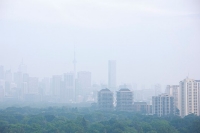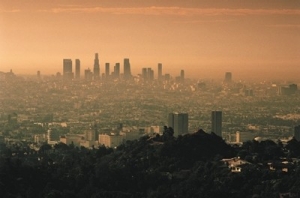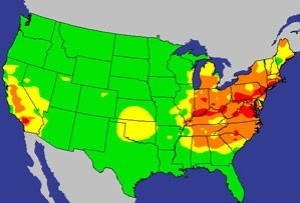Ozone

What is ozone?
How can ozone be “good” and “bad?”
The “good” ozone layer
How does depletion of “good” ozone affect human health and the environment?
What’s being done about depletion of “good” ozone?
What causes “bad” ozone?
How does “bad” ozone affect human health and the environment?
What is being done about “bad” ozone?
What can I do about ozone?
Additional resources
What is ozone?
Ozone is a gas that occurs both in the Earth's upper atmosphere and at ground level. Ozone can be "good" or "bad" for your health and the environment, depending on its location in the atmosphere.
How can ozone be both “good” and “bad?”
Ozone occurs in two layers of the atmosphere. The troposphere is the layer from ground level to about 6 miles up. Ground-level or "bad" ozone exists in the troposphere and is an air pollutant that is harmful to breathe. Ozone damages crops, trees, and other vegetation and is a main ingredient of urban smog. After 6 miles up the stratosphere starts. The "good" ozone layer extends upward from about 6 to 30 miles and protects life on Earth from the sun's harmful ultraviolet (UV) rays.
The “good” ozone layer
Ozone is produced naturally in the stratosphere by ultraviolet rays reacting with oxygen. But this "good" ozone has gradually been destroyed by human-made chemicals referred to as ozone-depleting substances (ODS), including chlorofluorocarbons (CFCs), hydrochlorofluorocarbons (HCFCs), halons, methyl bromide, carbon tetrachloride, and methyl chloroform. These substances were formerly used and sometimes still are used in coolants, foaming agents, fire extinguishers, solvents, pesticides, and aerosol propellants. Once released into the air these ozone-depleting substances degrade very slowly. They can remain for years as they move through the troposphere until they reach the stratosphere. There they are broken down by the intensity of the sun's UV rays and release chlorine and bromine molecules, which destroy the "good" ozone. Scientists estimate that one chlorine atom can destroy 100,000 "good" ozone molecules.
Even though we have reduced or eliminated the use of many ozone-depleting substances, their use in the past can still affect the protective ozone layer. Research indicates that depletion of the "good" ozone layer is being reduced worldwide. Thinning of the protective ozone layer can be observed using satellite measurements, particularly over the Polar Regions.
How does depletion of “good” ozone affect human health and the environment?
Ozone depletion can cause increased amounts of UV radiation to reach the Earth which can lead to more cases of skin cancer, cataracts, and impaired immune systems. Too much exposure to UV is believed to be contributing to the increase in melanoma, the most fatal of all skin cancers. Since 1990, the risk of developing melanoma has more than doubled.
UV can also damage sensitive crops, such as soybeans, and reduce crop yields. Some scientists suggest that marine phytoplankton, which are the base of the ocean food chain, are already under stress from UV radiation. This stress could have adverse consequences for human food supplies from the oceans.
What’s being done about depletion of “good” ozone?
The United States, along with over 180 other countries, recognized the threats posed by ozone depletion and in 1987 adopted a treaty called the Montreal Protocol to phase out the production and use of ozone-depleting substances.
EPA has established regulations to phase out ozone-depleting chemicals in the United States. Warning labels must be placed on all products containing CFCs or similar substances and nonessential uses of ozone-depleting products are prohibited. Releases into the air of refrigerants used in car and home air conditioning units and appliances are also prohibited. Some substitutes to ozone-depleting products have been produced and others are being developed. If the United States and other countries stop producing ozone-depleting substances, estimates suggest that natural ozone production should return the ozone layer to normal levels by about 2050.
What causes “bad” ozone?

Ground-level or "bad" ozone is not emitted directly into the air, but is created by chemical reactions between oxides of nitrogen (NOx) and volatile organic compounds (VOC) in the presence of sunlight. Emissions from industrial facilities and electric utilities, motor vehicle exhaust, gasoline vapors and chemical solvents are some of the major sources of NOx and VOC.
At ground level, ozone is a harmful pollutant. Ozone pollution is a concern during the summer months because strong sunlight and hot weather result in harmful ozone concentrations in the air we breathe. Many urban and suburban areas throughout the United States have high levels of "bad" ozone. But many rural areas of the country are also subject to high ozone levels as winds carry emissions hundreds of miles away from their original sources.
How does “bad” ozone affect human health and the environment?
Breathing ozone can trigger a variety of health problems including chest pain, coughing, throat irritation and congestion. It can worsen bronchitis, emphysema and asthma. "Bad" ozone also can reduce lung function and inflame the linings of the lungs. Repeated exposure may permanently scar lung tissue.

Healthy people also experience difficulty breathing when exposed to ozone pollution. Because ozone forms in hot weather, anyone who spends time outdoors in the summer may be affected, particularly children, outdoor workers, those with chronic health conditions and people exercising. Millions of Americans live in areas where the national ozone health standards are exceeded. The EPA has designated over 300 counties of the United States, clustered around the most heavily populated areas (especially in California and the Northeast), as failing to comply with the National Ambient Air Quality Standards. Nashville, Chattanooga, and Johnson City-Kingsport-Bristol area all have agreements with EPA to meet national ozone standards.
Ground-level or "bad" ozone also damages vegetation and ecosystems. It leads to reduced agricultural crop and commercial forest yields, reduced growth and survivability of tree seedlings, and increased susceptibility to diseases, pests and other stresses such as harsh weather. In the United States alone, ground-level ozone is responsible for millions of dollars in reduced crop production each year. Ground-level ozone also damages the foliage of trees and other plants, affecting the landscape of cities, national parks and forests, and recreation areas.
What is being done about “bad” ozone?
Under the Clean Air Act, EPA has set protective health-based standards for ozone in the air we breathe. EPA, state and cities have instituted a variety of programs to meet these health-based standards. Throughout the country, additional programs are being put into place to cut NOx and VOC emissions from vehicles, industrial facilities and electric utilities. Programs are also aimed at reducing pollution by reformulating fuels and consumer/commercial products, such as paints and chemical solvents, that contain VOC. Voluntary programs also encourage communities to adopt practices, such as carpooling, to reduce harmful emissions.
What can I do about high-altitude “good” ozone?
- Protect yourself against sunburn. When the UV Index is "high" or "very high" limit outdoor activities between 10:00 a.m. and 4:00 p.m., when the sun is most intense. Twenty minutes before going outside, liberally apply a broad-spectrum sunscreen with a Sun Protection Factor (SPF) of at least 15. Reapply every two hours or after swimming or sweating. For UV Index forecasts, check local media reports or visit: www.epa.gov/sunsafety/uv-index-applications.
- Use approved refrigerants in air conditioning and refrigeration equipment. Make sure technicians that work on your air conditioner or refrigerator are certified to recover the refrigerant. Repair leaky air conditioning units before refilling them.
What can I do about ground level “bad” ozone?
- Check the air quality forecast in your area. At times when the Air Quality Index (AQI) is forecast to be unhealthy, limit physical exertion outdoors. In many places, ozone peaks in mid-afternoon to early evening. Change the time of day of strenuous outdoor activity to avoid these hours, or reduce the intensity of the activity. For AQI forecasts, check your local media reports or visit: www.airnow.gov
- Help your local electric utilities reduce ozone air pollution by conserving energy at home and the office. Consider setting your thermostat a little higher in the summer and a little lower in the winter. Participate in your local utilities' load-sharing and energy conservation programs.
- Reduce air pollution from cars, trucks, gas-powered lawn and garden equipment, boats and other engines by keeping equipment properly tuned and maintained. During the summer, fill your gas tank during the cooler evening hours and be careful not to spill gasoline. Reduce driving, carpool, use public transportation, walk, or bicycle to reduce ozone pollution, especially on hot summer days.
- Use household and garden chemicals wisely. Use low VOC paints and solvents. Be sure to read labels for proper use and disposal.
Additional resources
U.S. Environmental Protection Agency (EPA)
Ozone Layer Protection
www.epa.gov/ozone-layer-protection
Ozone and Your Patient's Health Training Course
www.epa.gov/ozone-pollution-and-your-patients-health
Agency for Toxic Substances and Disease Registry (ATSDR)
Air Quality
www.atsdr.cdc.gov/general/theair.html
Centers for Disease Control and Prevention (CDC)
Ozone
www.cdc.gov/niosh/topics/ozone
Tennessee Department of Environment and Conservation (TDEC)
Division of Air Pollution Control
www.tn.gov/environment/program-areas/apc-air-pollution-control-home.html